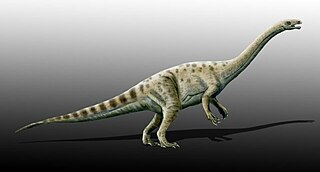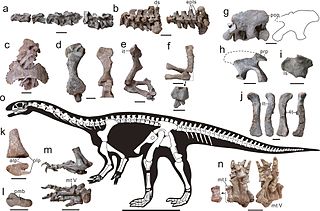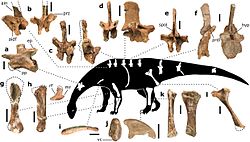
Melanorosaurus is a genus of basal sauropodomorph dinosaur that lived during the Late Triassic period. A herbivore from South Africa, it had a large body and sturdy limbs, suggesting it moved about on all fours. Its limb bones were massive and heavy like the limb bones of true sauropods.

Massospondylus was a genus of sauropodomorph dinosaur from the Early Jurassic. It was described by Sir Richard Owen in 1854 from remains discovered in South Africa, and is thus one of the first dinosaurs to have been named. Fossils have since been found at other locations in South Africa, Lesotho, and Zimbabwe. Material from Arizona's Kayenta Formation, India, and Argentina has been assigned to the genus at various times, but the Arizonan and Argentinian material are now assigned to other genera.

Isanosaurus is an extinct genus of sauropod dinosaur from Thailand. It was originally dated to approximately 210 million years ago during the Late Triassic, which would make it one of the oldest known sauropods. Its age was later considered uncertain, and may be Early Jurassic or even as young as Late Jurassic. The only species is Isanosaurus attavipachi. Though important for the understanding of sauropod origin and early evolution, Isanosaurus is poorly known. Exact relationships to other early sauropods remain unresolved.

Lessemsaurus is an extinct genus of sauropodiform dinosaur belonging to Lessemsauridae.

Antetonitrus is a genus of sauropodiform dinosaur found in the Early Jurassic Elliot Formation of South Africa. The only species is Antetonitrus ingenipes. Sometimes considered a basal sauropod, it is crucial for the understanding of the origin and early evolution of this group. It was a quadrupedal herbivore, like its later relatives, but shows primitive adaptations to use the forelimbs for grasping, instead of purely for weight support.

Blikanasaurus is a genus of sauropodomorph dinosaur from the late Triassic of South Africa. The generic name Blikanasaurus is derived from Greek, meaning "lizard from Blikana". The species name cromptoni is taken from the surname of A.W. "Fuzz" Crompton, an American paleontologist who led numerous field expeditions in Elliot Formation outcrop localities in South Africa. Blikanasaurus is only known from partial hindlimb bones that were recovered from the lower Elliot Formation (LEF) in the Eastern Cape.

Sanpasaurus is a poorly known sauropod dinosaur from the Early to Late Jurassic of Sichuan, China. The type species, S. yaoi, was described by Chung Chien Young, in 1944. The type remains, IVPP V.156, consists of 20 vertebrae, scapulae, forelimbs, and some hindlimb bones. Initially reported by Young as an ornithopod ornithischian, this specimen was unambiguously referred to Sauropoda in 2016 by McPhee et al., later refined to a basal gravisaurian position by Pol et al. in 2020 and 2022, closely related to Vulcanodon and Tazoudasaurus. Sanpasaurus is known from remains recovered from the Maanshan Member of the Ziliujing Formation.

Euskelosaurus is a sauropodomorph dinosaur from the Late Triassic of South Africa and Lesotho. Fossils have only been recovered from the lower Elliot Formation in South Africa and Lesotho, and in one locality in Zimbabwe.

Massospondylidae is a family of early massopod dinosaurs that existed in Asia, Africa, North America, South America and Antarctica during the Late Triassic to the Early Jurassic periods. Several dinosaurs have been classified as massospondylids over the years. The largest cladistic analysis of early sauropodomorphs, which was presented by Apaldetti and colleagues in November 2011, found Adeopapposaurus, Coloradisaurus, Glacialisaurus, Massospondylus, Leyesaurus and Lufengosaurus to be massospondylids. This result supports many previous analyses that tested fewer taxa. However, this analysis found the two recently described North American massopods, Sarahsaurus and Seitaad, and the South African Ignavusaurus to nest outside Massospondylidae, as opposed to some provisional proposals. Earlier in 2011, Pradhania, a sauropodomorph from India, was tested for the first time in a large cladistic analysis and was found to be a relatively basal massospondylid. Mussaurus and Xixiposaurus may also be included within Massospondylidae.

Anchisauria is an extinct clade of sauropodomorph dinosaurs that lived from the Late Triassic to the Late Cretaceous. The name Anchisauria was first used Haekel and defined by Galton and Upchurch in the second edition of The Dinosauria. It is a node-based taxon containing the most recent common ancestor of Anchisaurus polyzelus and Melanorosaurus readi, and all its descendants. Galton and Upchurch assigned a family of dinosaurs to the Anchisauria: the Melanorosauridae. The more common prosauropods Plateosaurus and Massospondylus were placed in the sister clade Plateosauria.

Massopoda is a clade of sauropodomorph dinosaurs which lived during the Late Triassic to Late Cretaceous epochs. It was named by paleontologist Adam M. Yates of the University of the Witwatersrand in 2007. Massopoda is a stem-based taxon, defined as all animals more closely related to Saltasaurus loricatus than to Plateosaurus engelhardti.

Matthew Bonnan is an American paleobiologist, a Professor of Biological Sciences at Stockton University, and as of 2021 a singer/songwriter. His research combines traditional descriptive and anatomical study with computer-aided morphometric analysis and modeling of vertebrate skeletons, and he is the co-discoverer of three new species of dinosaurs. He is the author of the book The Bare Bones: An Unconventional Evolutionary History of the Skeleton, designed to introduce undergraduates and curious lay readers to the anatomy and evolution of the vertebrate skeleton. Bonnan has a music/art outreach project, Once Upon Deep Time, a pop/rock song cycle about the evolution of hearing and our connection to the tree of life.

The Elliot Formation is a geological formation and forms part of the Stormberg Group, the uppermost geological group that comprises the greater Karoo Supergroup. Outcrops of the Elliot Formation have been found in the northern Eastern Cape, southern Free State, and in the eastern KwaZulu-Natal provinces of South Africa. Outcrops and exposures are also found in several localities in Lesotho such as Qacha's Neck, Hill Top, Quthing, and near the capital, Maseru. The Elliot Formation is further divided into the lower (LEF) and upper (UEF) Elliot formations to differentiate significant sedimentological differences between these layers. The LEF is dominantly Late Triassic (Norian-Hettangian) in age while the UEF is mainly Early Jurassic (Sinemurian-Pliensbachian) and is tentatively regarded to preserve a continental record of the Triassic-Jurassic boundary in southern Africa. This geological formation is named after the town of Elliot in the Eastern Cape, and its stratotype locality is located on the Barkly Pass, 9 km north of the town.

Aardonyx is a genus of basal sauropodomorph dinosaur. It is known from the type species Aardonyx celestae found from the Early Jurassic Elliot Formation of South Africa. A. celestae was named after Celeste Yates, who prepared much of the first known fossil material of the species. It has arm features that are intermediate between basal sauropodomorphs and more derived sauropods.

Arcusaurus is an extinct genus of sauropodomorph dinosaur from the Early Jurassic of South Africa.
Sefapanosaurus was an early, herbivorous sauropodomorph dinosaur occurring in the southern regions of Gondwana some 200 million years ago in the Late Triassic or Early Jurassic. The sauropodomorphs were the dominant terrestrial herbivores throughout much of the Mesozoic Era, from their origins in the mid-Triassic until their decline and fall at the end of the Cretaceous. A distinctive feature of this dinosaur is the cross-shaped astragalus or talus bone in its ankle. The generic name is derived from the Sesotho word sefapano, meaning ‘cross’ and the Greek word saurus, meaning 'lizard'. The specific name refers to Zastron, the type locality, where the specimen was discovered.

Xingxiulong is a genus of bipedal sauropodiform from the Early Jurassic of China. It contains a single species, X. chengi, described by Wang et al. in 2017 from three specimens, two adults and an immature individual, that collectively constitute a mostly complete skeleton. Adults of the genus measured 4–5 metres (13–16 ft) long and 1–1.5 metres tall. Phylogenetic analysis suggests that Xingxiulong is most closely related to its contemporary Jingshanosaurus, although an alternative position outside of both the Sauropodiformes and Massospondylidae is also plausible.

Lessemsauridae is a clade of early sauropodiform dinosaurs that lived in the Triassic and Jurassic of Argentina, South Africa and possibly Lesotho. A phylogenetic analysis performed by Apaldetti and colleagues in 2018 recovered a new clade of sauropodiforms uniting Lessemsaurus, Antetonitrus, and Ingentia which they named Lessemsauridae. It is a node-based taxon, defined as all descendants of the most recent common ancestor of Lessemsaurus sauropoides and Antetonitrus ingenipes. Depending on the definition of Sauropoda, Lessemsauridae is either one of the most basal sauropod taxa, or a sister taxon of Sauropoda. An additional member of the clade was named later in 2018, Ledumahadi. A 2021 study by Pol and colleagues also assigned the genera Kholumolumo and Meroktenos to the group.

Ledumahadi is a genus of lessemsaurid sauropodomorph dinosaur from the Early Jurassic Elliot Formation in Free State Province, South Africa. The type and only species is L. mafube, known from a singular incomplete postcranial specimen. A quadruped, it was one of the first giant sauropodomorphs, reaching a weight of around 12 tonnes, despite not having evolved columnar limbs like its later huge relatives.
Schleitheimia, is an extinct genus of sauropodiform sauropodomorph dinosaur, from the Gruhalde Member of Klettgau Formation of Switzerland. The type species, Schleitheimia schutzi was formally described in 2020.


































